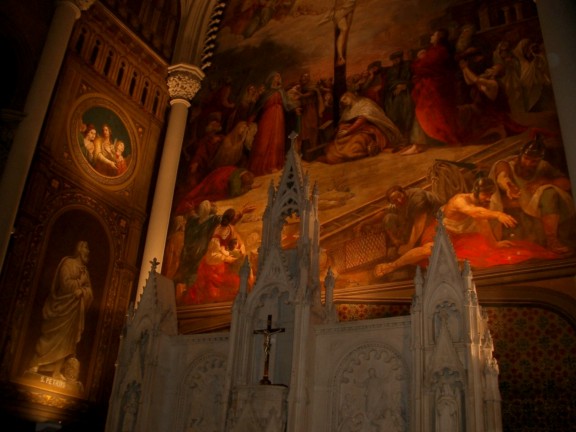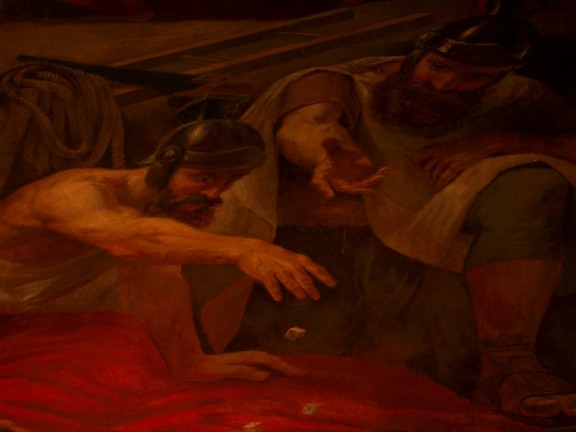|
no. 1 january - march 2004 Restoring Brumidi's Baroque Masterpieces
View of a portion of the completed restoration of Constantino Brumidi’s "The Crucifixion" the largest of its kind in the United States of America. The scene provides the background for the ornate altar that was used as the main altar of the church before the Second Vatican Council. (CITOC photo) At New York City’s St. Stephen’s Church, a parish of the St. Elias Province, the mural work of 19 th century artist Constantino Brumidi will eventually be revealed in all its splendor. Known mainly for his painting of the frescoes in the Capitol building of United States of America in Washington, D.C., Brumidi is also responsible for the 43 murals and paintings at Our Lady of the Scapular and St. Stephen Church in downtown Manhattan in New York City.The massive restoration effort to save these historic murals by the 19 th century baroque artist has begun. Aside from the USA Capitol building, St. Stephen’s is the only other major site of Brumidi’s work in the United States. Preserving his murals is of vital importance not only to the parishioners, but also to all lovers of art.Constantino Brumidi (1805-1880) was born in Rome, Italy. From 1818 to 1831, he studied painting and sculpture at the Academic di San Luca. In the 1840’s he was commissioned by Pope Gregory XVI and later by Pope Pius IX to work on restorations and portraits for the Vatican Palace. In 1852, at the age of 47, Brumidi emigrated to the United States of America. It is said that upon reaching America, Brumidi declared, "I have no longer any desire for fame and fortune. My one ambition and my daily prayer is that I may live long enough to make beautiful the Capitol of the one country on earth in which there is liberty." He was commissioned as an artist by both the U.S. government and the Rev. Edward McGlynn, pastor of St. Stephen’s, who had studied in Rome. Although McGlynn knew that buying paintings in Europe would be less expensive than creating the murals, he preferred to commission Brumidi. In 1856 and from 1868 until 1879, Brumidi painted the frescoes in the Capitol while Congress was in recess. When Congress was in session, he commuted to New York to paint the murals at St. Stephen’s. At that time St. Stephen’s was the most influential and largest Catholic parish in the United States, with 22,000 parishioners. Presently the parish has just 800 parishioners. St. Stephen’s was designed by architect James Renwick, who later designed New York’s Saint Patrick’s Cathedral and one of the Smithsonian Institution buildings in Washington, D.C. The church has more than 100 figurative, painted stained glass windows made by the renowned Meyer Studio in Munich, Germany. The Brumidi works in the church include a 22x44 foot mural, The Crucifixion, the largest of its kind in the nation. Brumidi was a master of trompe l’oeil, the technique of painting flat surfaces to give the illusion of three dimensional perspective. To complement the murals, Brumidi employed this technique on the walls of the church and its 54 massive columns. Unfortunately, decades ago, this was all painted over and must now be uncovered and restored. History does repeat itself. The president of the company restoring the Brumidi works in the church also worked on the restoration of Brumidi’s frescoes in the U.S. Capitol building. The restoration project is expected to take seven years and cost at least US$ 4 million. So far three of the most severely damaged murals have been restored.
Detail of the Roman soldiers tossing dice at the foot of the Cross in the mural entitled "The Crucifixion." (CITOC photo) |
|
RETURN TO THE INDEX FOR 2004 | RETURN TO THE INDEX FOR THIS ISSUE INDEX OF CARMELITE
WEBSITES |

